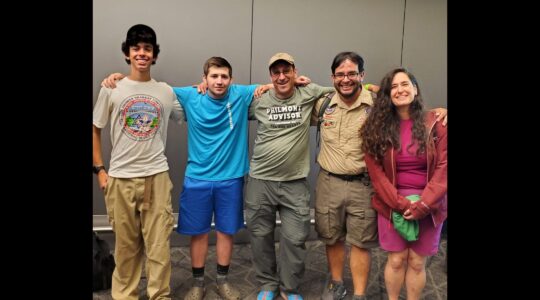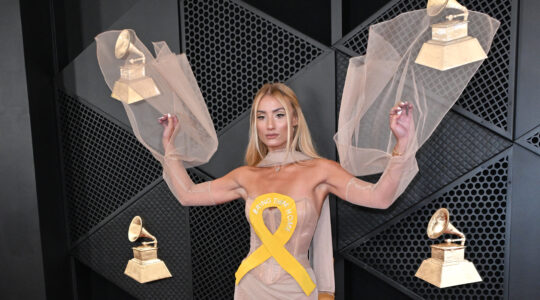SAN FRANCISCO (JTA) — Passover, which commemorates the Jewish people’s liberation from slavery, has a political message at its heart. So it’s not surprising that the seder – especially the seder plate — has been pressed into the service of all kinds of freedoms.
The country’s first Freedom Seder, held in a Washington church on the third night of Passover on April 4, 1969, marked the first anniversary of the assassination of the Rev. Martin Luther King Jr. Participants used a Haggadah focused on black-Jewish solidarity that was rewritten by the Shalom Center, a Jewish peace group. The 800 guests included blacks and whites, Jews and Christians.
Since then, Freedom Seders have focused attention on women’s rights, the environment, anti-war protests, interfaith dialogue, Jewish-Muslim dialogue and labor issues, as well as black-Jewish relations.
Last week in Tel Aviv, nearly 500 African migrant workers joined Israeli supporters at a “refugee seder” near the city’s central bus station, a neighborhood populated by many illegal workers. A spokesman for the workers told reporters that many could not attend the event last year, which was held closer to Passover, because they were busy cleaning Jewish homes for the holiday.
In the 1980s, some American Jews added a fourth matzah to the three traditionally placed on the seder table to symbolize Soviet Jews who were not free to celebrate Jewish holidays. Similarly, some Haggadahs added a fifth child to the traditional Four Sons, representing a child who died in the Holocaust and was not able to be present at the seder.
Instead of refashioning their entire seder, many people add items to the seder plate in the name of one cause or another.
The traditional seder plate contains an egg, shank bone, karpas, charoset and maror. Some also make room for the hazeret, another kind of bitter green. But other fruits and vegetables have showed up recently, representing everything from solidarity with oppressed Jewish communities to welcoming the intermarried.
Miriam’s cup, used to symbolize the feminist presence in Jewish liturgy and ritual, first appeared in Boston Rosh Chodesh women’s groups in the 1980s and quickly moved to the seder table.
More commonplace at liberal seders today is the orange, which has come to symbolize the power of Jewish women — from female rabbis to the role played by Jewish midwives in the Exodus story.
But when Dartmouth College Jewish studies professor Susannah Heschel first plunked down a tangerine on her seder plate in the early 1980s, it was in the name of gay and lesbian inclusion, not women’s rights in general.
“During the first part of the seder, I asked everyone to take a segment of the orange, make the blessing over fruit, and eat it as a gesture of solidarity with Jewish lesbians and gay men, and others who are marginalized within the Jewish community,” she wrote in 2001 on Miriamscup.org. “In addition, each orange segment had a few seeds that had to be spit out — a gesture of spitting out, repudiating the homophobia that poisons too many Jews.”
A few years ago, olives started showing up on the seder plate as a call for peace between Israelis and Palestinians.
In 2008, Jewish Voice for Peace promoted putting an olive on the seder plate as part of its Trees of Reconciliation project, which sought to donate 3,000 olive saplings to Palestinian farmers to replant trees torn down to make room for Jewish settlements in the West Bank.
The Shalom Center suggests that celebrants include both an olive and orange on their seder plates.
“Why this olive?” reads the group’s 2009 “Freedom Seder for the Earth” Haggadah. “Because for millennia the olive branch has been the symbol of peace, and we seek to make peace where there has been war.
“Why this orange? Because in olden days there was no orange on the Seder Plate and it was said that outsiders — gay men and lesbians, transgendered people, converts, those who lack some important ability or skill, the unlearned — all these no more belonged in the community than an orange belongs upon the Seder plate. So we place an orange to say firmly, All these belong in our communities.”
How about an artichoke? Rabbi Geela Rayzel Raphael suggests this prickly vegetable with the soft heart for the interfaith-friendly seder plate.
“Like the artichoke, which has thistles protecting its heart, the Jewish people have been thorny about this question of interfaith marriage,” she writes on Interfaithfamily.com.
Hunger is a popular cause during Passover, focused as the holiday is on dietary restrictions.
In 2010, according to the Jewish Council for Public Affairs, more than 40 “hunger seders” focusing on the nutritional needs of low-income children and adults were organized in 30 separate cities.
The Progressive Jewish Alliance, which has branches in Los Angeles and the San Francisco Bay Area, took up that banner last year with its Food Desert Seder Plate, which was designed to alert Jews to the lack of access to fresh, healthy food in many low-income neighborhoods.
Instead of a nice, crisp lettuce leaf, they suggest a rotten piece of lettuce to remind participants that inner-city grocery stores often carry only spoiled produce. A potato chip instead of the potato often used for karpas alludes to the fact that high-fat, low-nutrition potato chips are cheaper and easier to find in such neighborhoods than whole, raw vegetables.
This spring, chocolate and coffee beans will show up on some seder plates as part of a campaign by Fair Trade Judaica to highlight Jewish concern for forced child labor in those industries.
A Haggadah supplement prepared by Global Exchange, one of Fair Trade Judaica’s partners in this campaign, includes the following proposed exchange between the seder leader and participants after the Maggid, or telling of the Passover story, and before the blessing on the matzah, bitter herb and charoset:
Leader: Once, we were slaves in Egypt.
Assembled: Today, young children are toiling in the West African cocoa fields.
Leader: Just as Moses grew up in the house of the Pharaoh, we have influence over those who exploit children in the cocoa fields.
Assembled: We can walk in Moses’ footsteps. We can have the courage to ask the Pharoahs of today to let the children go.
JTA has documented Jewish history in real-time for over a century. Keep our journalism strong by joining us in supporting independent, award-winning reporting.





